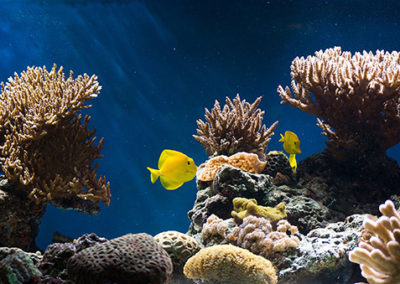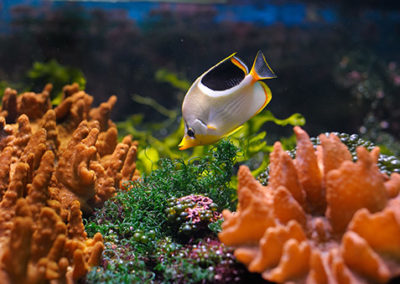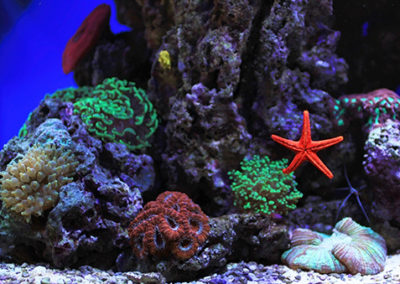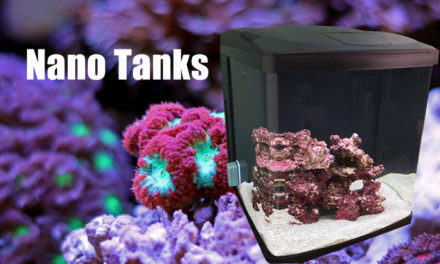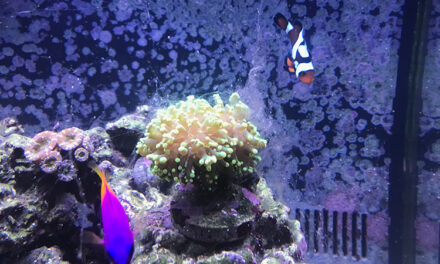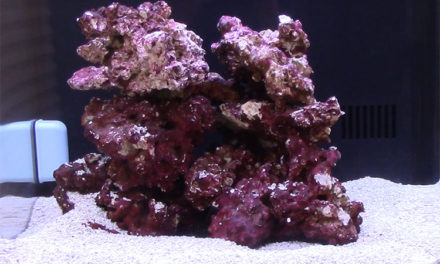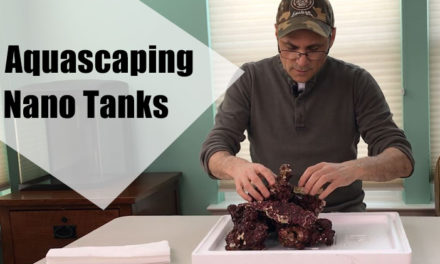There are a few methods to cycle a reef tank, and include the decision to cycle with or without fish. In the end, you will achieve the same result. Just keep in mind all methods require time and patience.
Six methods to cycle a nano reef tank:
1. Without Fish
2. With Fish
3. With Fish Food
4. Use Existing Bacteria (from an established tank)
5. Use Ammonia
6. Live Rock
Cycle your reef tank without fish
For the cycling process to work, ammonia is required. There are many ways to produce ammonia, however, ammonia is mostly produced from fish waste or decomposing matter. As you cycle your tank, bacteria changes the ammonia into nitrite. If fish are present during this time, the ammonia levels can become dangerous. Hence, many aquarists choose to cycle their tanks without fish.
Cycle your reef tank with fish
Using fish to cycle your reef tank is effective, however, many times this will cause stress and danger for the fish (also referred to as starter fish). Some fish do better than others, however, it is a matter of preference. Ask your local fish store which fish they recommend.
Cycle your reef tank with fish food
This process is fairly straightforward. Just add fish food (as you normally would feed your fish) on a daily basis. The food will decompose and in-turn creates the ammonia needed to cycle your tank.
Cycle your reef tank with bacteria
Using the existing bacteria from an established saltwater tank, is a great way to reduce the time to cycle your reef aquarium. Grab the floss/medium from the established tank for use in the tank you are cycling. You can also use the substrate from the established tank. Please note however, that substrate can harbor disease and can easily be transferred.
Cycle your reef tank using ammonia
As you may have guessed, add ammonia to the water. It’s important to follow the manufacturer’s instructions, but is straight forward. Using a dropper, you will add the ammonia on a daily basis until you get a nitrite reading. Then you slowly reduce the dosages until the ammonia and nitrite levels are zero. A final step includes a major water change.
Cycle your reef tank with live rock
Cycling a nano reef tank with live rock, is effective and is what we will spend the rest of this article discussing. With some patience and time, you are sure to have your aquarium up and running. Hopefully, you are eager to keep your reef tank for several years, so taking your time makes sense.
Although most retailers have the best intentions, you can never completely trust live rock. It’s hard to determine how much “die-off” live rock may have on it.
supplies you will need:
- Small aquarium
- Dry or live sand
- Sea salt
- RO or RO/DI unit
- TDS tester
- Heater
- Test kit (ammonia, nitrite, and nitrate at a minimum)

Why is live rock effective in cycling a reef tank?
The sort answer: live rock has a ton of beneficial bacteria. Bacteria and organisms that live on the live rock die at the time the rock is shipped from the ocean to your local pet store. Adding the live rock to your reef tank will “kick-off” the nitrogen cycle when the organic matter begins to decompose. During this process, ammonia is released that is beneficial to the bacteria.
Note: you should limit the amount of time your run your lights – about 2-3 hours per day while you are cycling is plenty. There are numerous schools of thought regarding lighting your tank during the cycling process – such as setting a 10-12-hour schedule. Personally, I have had luck sticking with minimal lighting during cycling.
Finally, do not perform any water changes, until you have completed all the steps during the cycling process.
How to Get Started Cycling Your Nano Reef Tank
Before you start cycling your tank, you should set a plan which includes the layout of your aquascape. We have written a great article regarding aquascape here. The structure of your rock will play an important role after your tank is fully cycled.
To begin, install at least half of the live rock that you plan on using. After you install the live rock, the process of cycling the water will start. In about three days, you should take your first reading of ammonia. I would suggest that you continue to test the ammonia every few days. Note, the readings will rise and eventually drop to zero. You will want to monitor the ammonia and nitrite levels. Depending upon the die-off on the live rock, it could take a couple weeks. Many articles surrounding the cycling of saltwater tanks state 4-6 weeks, however, I my experience, nano tanks cycle much quicker.
The nitrite cycle is similar to the ammonia cycle. You should test nitrite levels every 3 days, as well. When the nitrite readings get to zero, you should start to test for nitrate. Testing your tank water for ammonia, nitrites and nitrates on a regular basis will provide useful data to identify how well the bacteria population is increasing. Monitoring these readings on a regular basis will enable you to take additional steps to better control these levels if needed. Once your tank is fully cycled, you are ready for the next step, add animals!
Related Questions
When can I add invertebrates when cycling my reef tank?
After about 4 weeks (or sooner), you can start to add some invertebrates such as snails, shrimp, hermit crabs. The inverts will consume food and produce ammonia. Keep an eye on the ammonia and nitrite levels during this time.
When can I add fish when cycling My Reef Tank?
We do not suggest that you add fish during the tank cycling process, assuming you have chosen to cycle without fish. Once you have the ammonia, nitrite and nitrate levels in check, you can begin to add fish slowly. I would not add more than one fish per week. By taking your time, you will be in a better position to take further action in case any parameters “spike.”
When can I add corals when cycling a saltwater aquarium?
You should wait until the Nitrogen Cycle is complete before adding corals. Many reef enthusiasts chose to add corals sooner (with success), however, I wouldn’t be in any rush. Corals are expensive and could be exposed to unnecessary danger. Why not wait it out?
It’s also a great idea to make sure all your tank parameters are in check including: alkalinity, ammonia, calcium, nitrate, nitrite, pH, salinity, and temperature. You will need to have a maintenance plan in place, so its best to start one early.
When should I change the water after cycling my reef tank?
I would suggest that you perform a 25% water change after the cycling process is complete. This will help ensure that any animals you add have a better chance of acclimating!



